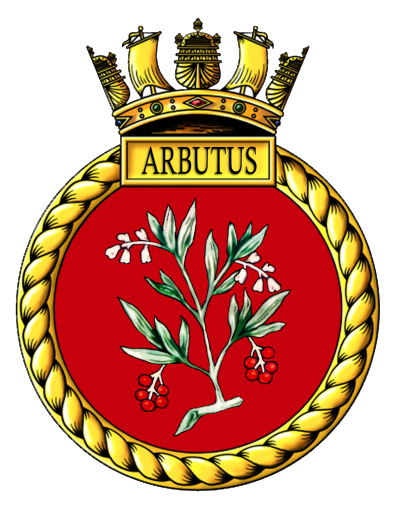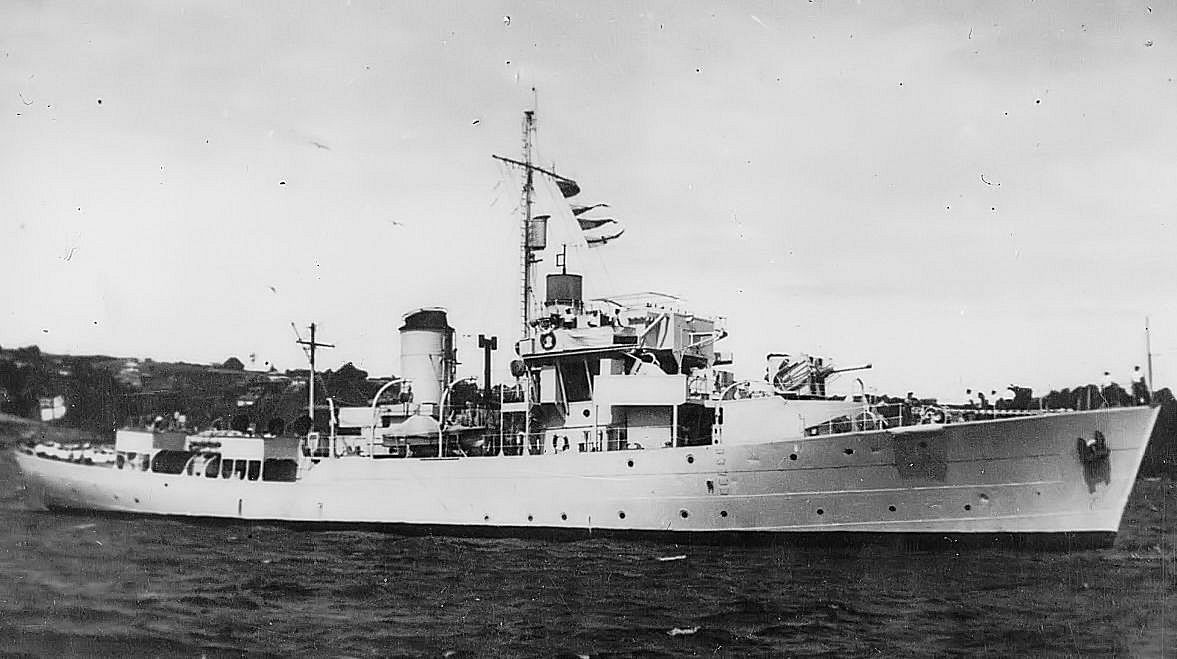Radio & Radar Repair Ship

Battle Honours
North Atlantic 1940-42
Specifications
Builder: eorge Brown & Co, (Marine) Ltd., Greenock, Scotland.
Displacement: 980 tons
Length: 193 ft
Beam: 33 ft
Draught: 17 ft
Speed: 16 Knots
Crew complement: 85
Commanding Officers
Lt. Cdr. John Alexander Rhind, RNZNVR 15 Feb 1944
Lt. Nigel Deerness Blair, RNZNVR 09 Feb 1945
Lt. Cdr. J. F. A. O"Neil, D.S.C., RNZN 15 May
1946
Related items
None
Reminiscences
None
Gallery
None
H.M.N.Z.S. ARBUTUS

Early history
Ordered as HMS ARBUTUS (II), a revised Flower Class Corvette, and laid down at the George Brown & Co shipyard in Greenock, Scotland. She was launched on January 26th 1944 and was transferred to the Royal New Zealand Navy on completion. She commissioned as HMNZS ARBUTUS on July 5th 1944, Lt. Cdr. J. A. Rhind, RNZNVR in command. She was to carry the pennant number K 403.
She sailed from Greenock on August 1st as an additional escort for Convoy O-S 85/ K-M-S 59, which sailed from Liverpool; ARBUTUS remained in company as far as the Azores Islands. She then proceeded to Bermuda, from there she sailed for the Panama Canal, and on to San Diego. She then sailed for Pearl Harbour, and Suva. ARBUTUS was severely damaged on October 7th when she grounded on a reef off Viwa Island, the westernmost of the Fiji Islands. She was shuck fast and had to be towed off by HMNZS AROHA and on to Suva, from where she was towed to Auckland, arriving there on October 27th. A survey showed that, in addition to the loss of the rudder blade, the bearing casting of the rudder stock had been fractured, the tail shaft bent, the propeller blades broken and bent, and the ship's bottom cut up for a length of about 25 feet. The ARBUTUS remained at Auckland for nearly three months awaiting the local fabrication of a new rudder and castings, and the arrival from the UK of a new propeller and tail shaft. In January, she was towed to Lyttelton, where permanent repairs were made and the work was completed by the end of April 1945.
Reallocated to the British Pacific Fleet
On February 9th 1945, Lieutenant N. D. Blair was appointed to command her; it had originally been intended that she would operate with the 25th Minesweeping Flotilla, but instead the New Zealand Naval Board offered her for service to the British Pacific Fleet. The offer was accepted and in May she was sent to Sydney where she was fitted out for radio and radar repair and servicing duties with the Fleet Train.
ARBUTUS left Sydney on July 4th and, after a call at Manus Island to embark a New Zealand radar officer and three radar mechanics, joined the Fleet Train in Japanese waters on July 28th. As part of Logistic Group Task Unit 112.2.6 ARBITUS was at sea with tankers WAVE GOVERNOR, CARELIA, OLNA, and WAVE KING, V.S.I.S. (Victualling Store Issuing Ship) GLENARTNEY, Armament Store Issuing Ships ROBERT MAERSK and CORINDA, escort carriers CHASER, SPEAKER, and RULER, destroyers NORMAN, and QUEENBOROUGH, sloops CRANE, PHEASANT, WOODCOCK, and REDPOLE, frigates ODZANI, and DERG and the minesweeper PIRIE. At 0900 hours on July 31st, vessels of the British Pacific Fleet (Task Force 37) rendezvoused with TU 112 in replenishment area, 'BRITISH TIZZY'; replenishment commenced at 1000 hours. The weather in the area was less than ideal, with a heavy swell running caused by a succession of typhoons to the east of the area. However, because the British were now mastering Replenishment At Sea (RAS) the weather did not affect the operation as much as it would have done just a few weeks earlier. TF 37 departed the replenishment area on August 2nd to prepare for the next round of strikes against the Japanese homeland.
During the three days that she was on station with the Logistic group ARBUTUS went alongside no fewer than forty ships to tranship stores and spare parts and service their radar equipment. On August 8th ARBUTUS and two other small ships left Leyte to escort three supply ships back to base at Manus Island. When she arrived at Manus on the 17th, the ARBUTUS had completed a continuous period at sea of 33 days and steamed 7600 miles without a stop of her main engines. She next sailed from Manus on August 30th to escort a number of supply ships to Hong Kong, where she arrived in time for the Japanese surrender of the Colony which took place on September 16th. She sailed from Hong Kong bound for Auckland via Manus, arriving there on September 26th, continuing on passage the following day. ARBUTUS arrived at Auckland on October 1st, having steamed more than 20,000 miles in 77 days since leaving Sydney.
Post War history
After her return to New Zealand she was employed for a brief period on a scientific expedition to the Three Kings Islands. After the successful completion in June 1946, of the clearance of the German minefield laid in the approaches to the Hauraki Gulf, the ships of the 25th Minesweeping Flotilla, with the exception of HMNZS ARBUTUS were placed in reserve.
After working-up in the Hauraki Gulf HMNZS ARBUTUS, now commanded by Lt-Cdr J. F. A. O'Neil, D.S.C., RNZN. was dispatched on a goodwill cruise to the islands in the New Zealand dependencies of the Cook and Samoan Group, and to French Oceania, American Samoa, and the British Crown Colony of Fiji, departing from Wellington on 20th September 1946. Arrangements were made to transport the French Minister, Monsieur Gazel, from Rarotonga to Papeete. HMNZS ARBUTUS completed her cruise, and arrived back in Auckland on 1st December 1946.
In January 1947, ARBUTUS carried out exercises in the Hauraki Gulf, she also attended the ceremony commemorating the landing of the first Governor, Captain Hobson, RN, at Waitangi, returning from there to Auckland to act as flag-ship at the annual Kawau regatta. During March and April 1947 ARBUTUS and an HDML were placed under the operational command of the Commanding Officer of the cruiser HMNZS BELLONA, as she worked up in the Hauraki Gulf.
The corvettes ARABIS and ARBUTUS were returned to the Royal Navy in 1948 when the six Loch class frigates HAWEA, KANIERE, PUKAKI, ROTOITI, TAUPO, and TUTIRA were purchased for the Royal New Zealand Navy.
Last modified: 23 February 2023
Primary information sources
Additional sources:
Waters S.D. (1956) The Royal New Zealand Navy – The official story of New Zealand in the Second World War 1939 – 45, Wellington, Historical Publications Branch http://nzetc.victoria.ac.nz/tm/scholarly/tei-WH2Navy.html
Extract taken from the report to the New Zealand government by the New Zealand Naval Board 1st April 1946 to 31st March 1947 http://rnzncomms.org/ourhistory/nznbr-1946/
Comments (0)